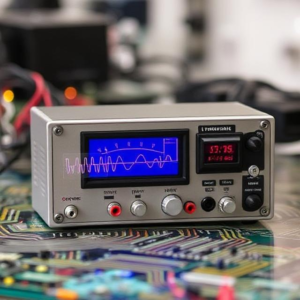What is an Oscillator?
An oscillator is a device or circuit that produces a repeating signal. This signal can be in the form of a wave (like a sine wave or square wave) that oscillates (or goes up and down) at a consistent frequency.
Think of it like a pendulum swinging back and forth at a regular pace. Instead of a pendulum, though, an oscillator creates an electrical signal that swings between high and low values in a regular pattern.

How Does an Oscillator Work?
- Power Source: You need a power source (like a battery or electrical supply) to start the process.
- Feedback Loop: The oscillator has a feedback loop where part of the signal it produces is fed back into the circuit, reinforcing the process of oscillating.
- Frequency: The frequency is how often the signal repeats itself. This is measured in Hertz (Hz), which means the number of cycles per second.
- Waveform: The shape of the wave can vary – it could be a sine wave, square wave, or triangle wave, depending on the design of the oscillator.
Types of Oscillators:
- Sinusoidal Oscillators: Produce smooth, continuous sine waves.
- Square Wave Oscillators: Produce square waves, which switch abruptly between high and low.
- Triangle Wave Oscillators: Produce a wave that rises and falls in a triangular shape.
Example:
- A simple example is the clock generator in a computer, which provides a regular pulse of timing to keep things synchronized.
What is a Frequency Synthesizer?
A frequency synthesizer is a more complex device or circuit that creates a wide range of different frequencies (not just a single frequency like a regular oscillator). It uses oscillators as part of its design to generate many different signals, which are all related to each other in some way.
A frequency synthesizer can produce a series of frequencies that are mathematically related, such as multiples or fractions of a base frequency.
How Does a Frequency Synthesizer Work?
- Base Oscillator: It starts with a base frequency produced by an oscillator.
- Frequency Division and Multiplication: It can multiply or divide this base frequency to create new frequencies. For example, if you start with a base frequency of 10 MHz, a synthesizer could create frequencies like 20 MHz, 5 MHz, and others.
- Control Logic: The synthesizer uses logic to generate different frequencies by adjusting settings, like dividing or multiplying the base frequency.
Example of Frequency Synthesizer:
- A radio transmitter uses a frequency synthesizer to generate different frequencies for broadcasting, allowing you to tune into different radio stations.
Difference Between Oscillators and Frequency Synthesizers
- Oscillators:
- Produce a single frequency or waveform.
- Examples: Quartz crystal oscillators in watches or microcontrollers in computers.
- Frequency Synthesizers:
- Can generate a wide range of frequencies, often based on one or more oscillators.
- Examples: Radio communication systems or signal generators in testing equipment.
Why Are Oscillators and Frequency Synthesizers Important?
- Communication:
- They are used in radios, television transmitters, and cell phones to create the signals needed to transmit and receive information.
- Timing and Synchronization:
- Computers and electronic devices rely on oscillators to keep everything in sync. For example, a computer uses an oscillator (called a clock generator) to time operations.
- Signal Generation:
- Engineers use frequency synthesizers to generate test signals in laboratories when designing or testing new equipment. This is useful in things like testing radios, cell phone networks, or wireless systems.
Examples of Where Oscillators and Frequency Synthesizers Are Used
- Radios:
- In radios, oscillators create the radio frequency signals, and synthesizers help create multiple stations by generating different frequencies.
- Cell Phones:
- A frequency synthesizer helps a cell phone generate different frequencies for communication (like sending and receiving calls or data).
- Test Equipment:
- In a laboratory or repair shop, engineers use signal generators (which are a type of frequency synthesizer) to test other devices by generating different frequencies and waveforms.
- Microprocessors:
- In computers and microcontrollers, oscillators generate the timing signals needed for everything to work in sync. For example, the clock speed of a CPU is determined by an oscillator.
Summary
- Oscillators generate a single frequency or waveform, like a sine wave or square wave. They are used in everything from watches to microprocessors.
- Frequency Synthesizers are more advanced devices that generate multiple frequencies, often based on a single base frequency. They are used in communication systems, radios, and testing equipment.
- Both are essential for making modern electronics work—whether it’s for communication, timing, or generating signals for testing purposes.
Tags: 10 MHz, 20 MHz, 5 MHz, base oscillator, battery, broadcasting, cell phones, circuit, clock generator, clock speed, Communication, Communication Systems, complex device, Computer, Computers, consistent frequency, control logic, CPU, device, electrical signal, electrical supply, electronic devices, Electronics, engineers, Feedback Loop, Frequency, frequency division, frequency multiplication, frequency synthesizer, Hertz, high and low values, Hz, laboratories, microcontrollers, Microprocessors, multiple frequencies, operations, oscillates, Oscillator, pendulum, power source, quartz crystal oscillator, radio communication systems, radio transmitter, Radios, repeating signal, signal generation, signal generators, sine wave, single frequency, sinusoidal oscillator, square wave, square wave oscillator, summary, synchronization, television transmitters, test signals, testing equipment., timing, timing pulse, timing signals., triangle wave, triangle wave oscillator, tuning, watches, wave, waveform, wireless systems


